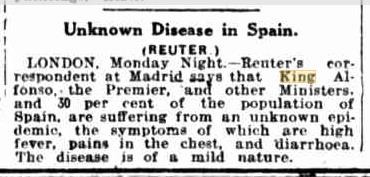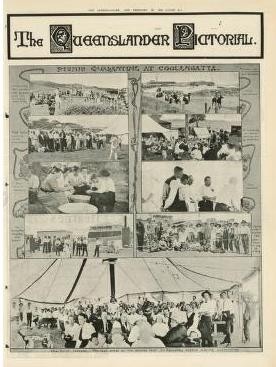As the cooler weather approaches and we start preparing for the flu season, spare a thought for generations past who were not able to access the antibiotics and flu vaccinations that are available to us today.
Flu epidemics had left their mark on Queenslanders in the 1890s, but the Spanish Flu, first seen in mid-1918 in Europe, was like nothing the world had seen before.
Early newspaper reports from 1918 refer to the “unknown disease” or the “New German disease” caused by “German Poison”. However, it became known as “Spanish Flu” and later the Influenza Pandemic of 1919. Why Spain? Spain was a neutral country in World War 1, so news from there was not censored. This led to a belief that the influenza epidemic was more widespread in that country. King Alfonso XIII of Spain did contract the disease, but he recovered.

Daily Mail, Wednesday 29 May 1918, page 6
As millions of servicemen and women returned home after World War 1, to be happily re-united with their families, little did they realise that they brought the deadly influenza germs with them.
Victoria was first hit, in January 1919, followed by New South Wales in March 1919. Queensland’s first case was notified in Brisbane on 3 May 1919, and by 30 June 1919 there were 20,699 notified cases.
Queensland’s response included gazetting Pneumonic Influenza as an infectious disease on 29 January 1919. Due to difficulty in differentiating between Influenza and Pneumonic Influenza, both became infectious diseases. Popular gathering places were closed, due to the infectious nature of the disease. The Public Library of Queensland (now the State Library of Queensland) closed, and the Royal Queensland Show (the Ekka) was not held as the grounds were used as a hospital camp with the erection of temporary huts.
Ships coming to Queensland ports were placed in quarantine along the Queensland coast and quarantine camps were set up on border crossings at the McIntyre River, Goondiwindi; at Wallangarra railway station; and at Coolangatta / Tweed Heads. Travellers were quarantined for 7 days, and they paid 7 shillings and 6 pence per day for the privilege, however the inoculations were free.

Picnic quarantine at Coolangatta. Photos by C.G. Simpson and R.J. Belbin. Digitised from The Queenslander, 22 February, 1919. State Library of Queensland, Image number: 702692-19190222-0021.
The atmosphere in the quarantine camps seemed almost festive, according to “Picnic quarantine at Coolangatta” published on page 21 of the Queenslander Pictorial supplement to The Queenslander on 22 February 1919.
The sad truth was that 830 Queenslanders died of Influenza in 1919, compared with 122 in 1918 and 33 in 1917, with a further 200 dying of Pneumonic Influenza, a category which hadn’t existed in previous years.
Further Reading
SLQ and the Spanish Flu (Chronicles of State Library of Queensland): /blog/jol/2016/03/15/slq-and-the-spanish-flu-chronicles-of-state-library-of-queensland/
Queensland Aborigines and the Spanish Influenza Pandemic of 1918-1919: /blog/ww1/2014/12/17/queensland-aborigines-and-the-spanish-influenza-pandemic-of-1918-1919/
Katy RobertsLibrary Technician, Visitor Services
Comments
Your email address will not be published.
We welcome relevant, respectful comments.